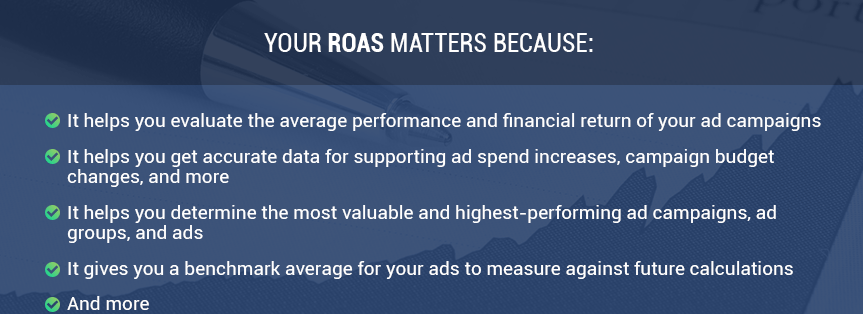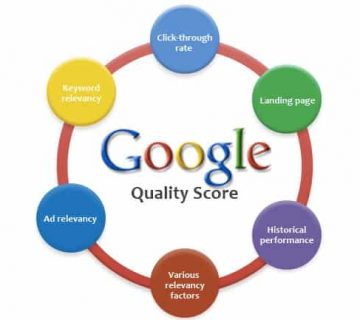What is ROAS?

Return on ad spend, also known as ROAS, describes a marketing metric that assesses the performance and financial return of a digital advertising strategy, campaign, or ad group. Using and measuring this metric can help companies improve their ad strategies and monetary returns.
How to calculate ROAS with 1 simple formula
You can calculate the return of your advertising efforts with the ROAS formula:
ROAS = Revenue / Cost
With this formula, your team can find your company’s unique ROAS value by determining the following:
- The total revenue (in a dollar amount) generated by your ad strategy
- The total cost (in a dollar amount) of managing your ad strategy
Once you have those two pieces of data, divide your total revenue by your total cost, and voilà!
Your ROAS is expressed as a dollar amount and represents what your company earns back (on average) for every dollar spent on your ad campaign. If yours equaled $5, for instance, that would mean your business earns $5 for every $1 spent.
[Example] How to use the ROAS formula
Check out the fictional example below to gain perspective on how to calculate your ROAS.
Acme Industries promotes its widgets with a series of social media campaigns, as well as paid search campaigns. Right now, though, the company wants to calculate the return of its paid search efforts for the month.
It’ll use the ROAS formula to look at the revenue and cost of its paid search campaigns.
The team totals its costs and discovers the following monthly expenses:
- Ad spend: $2500
- Software: $100
- Management fees: $800
- Total cost: $3400
Next, Acme Industries needs to calculate the revenue generated by its paid search campaigns.
When it comes to estimating ad revenue, Acme Industries needs to consider a few factors. First, they must determine how much a new lead is worth to their business. Second, they need to calculate the total profit margin for different purchases.
Once they do that, they can calculate their ad revenue.
Following its calculations, Acme Industries finds:
- 8 new leads (at $500 per lead): $4000
- 3 new purchases of Product A (at $250 per purchase): $750
- 1 new purchase of Product B (at $450 per purchase): $450
- Total ad revenue: $5200
Now, the Acme Industries team can input all their data into the ROAS formula:
ROAS = Total Revenue / Total Cost
ROAS = $5200 / $3400
ROAS = $1.50
For Acme Industries, their paid search campaigns generate $1.50 (on average) for every $1 spent.
Are you wondering whether Acme Industries earned a good ROAS from its ad strategy?
Good, because you should!
Understanding whether you’re delivering a good, bad, or average return on ad spend is essential. It helps you and your team determine a benchmark for your ad strategies, as well as if your company can improve the performance of its ad campaigns.
What is a good ROAS?
A “good” ROAS depends on several factors, but most companies earn $2 for every $1 invested.
This average comes from pay-per-click (PPC) ad strategies which are the most common when it comes to digital advertising. Due to the popularity of PPC, this number comes from a massive pool of data.

Industry-wide, however, most businesses aim for a $4 return — or 4:1.
When it comes to determining a good ROAS for your company, you need to think about the following:
- Your industry
- Your profit margins
- Your average cost-per-click (CPC)
Once you figure out these details, you can uncover the optimum dollar amount for your business.
Why should ROAS matter to your business?
Your ROAS should matter to your team and company for a few reasons, including:

- Evaluate the average performance and financial return of your ad campaigns
- Get accurate data for supporting ad spend increases, campaign budget changes, and more
- Determine the most valuable and highest-performing ad campaigns, ad groups, and ads
- Obtain a benchmark average for your ads to measure against future calculations
- And more
Overall, calculating your ROAS informs your company and your team about the performance and quality of your ad campaign.
It provides you with actionable and insightful data that you can use to optimize your ad spend. If you skip the formula and guess about the performance of your ad campaigns, it becomes easy to waste your ad spend and diminish the number of leads and sales coming in from advertising.
How is ROAS different from ROI?
When talking about ROAS, it’s natural to ask how it’s different from ROI.
ROI calculates how much your company makes from advertising (or another channel) after expenses, which includes operational costs, turnover, and more. In comparison, ROAS determines how much your business earns (on average) from advertising only.
Since they measure different aspects of your campaign, ROAS and ROI also use different formulas.

If you’re struggling to remember the differences between ROI and ROAS, think about the two from this perspective. ROAS measures your average return from advertising while ROI measures your total return from advertising.
3 ways your company can make its ROAS 10x better
Like your competitors, you want to improve your ROAS to maximize the performance of your ads.

With these three tactics, you can improve your ads and takes your return on ad spend to new levels:
1. Launch a branded PPC campaign
A branded PPC campaign, which targets your company’s name, can help your business earn a better return from your advertising efforts. Branded searches often generate conversions because users searching for a brand generally want to make a purchase or contact the company.
2. Use negative keywords
Negative keywords can also help improve your ROAS. With negative keywords, you prevent your ads from appearing in searches that feature those keywords. These keywords, while similar to your targeted keywords, tend to go outside the scope of your business, products, or services.
If your company runs a series of recruitment ads, for example, you may add these negative keywords:
- Careers
- Resumes
- Job openings
Take a look at your ad campaigns and see where you can take advantage of negative keywords.
3. Optimize landing pages for speed, usability, and conversion
Your landing page, or where your ads send users when they click, can have a tremendous impact on your ad performance. Campaigns that use slow-loading, clunky-looking pages almost always throw away valuable leads and sales because those landing pages provide such an unfriendly user experience.
If you want your landing pages to make buying your products or contacting your team easy, you need a fast, reliable, and easy-to-use page. You can take care of these tasks in-house, though you’ll need a web designer and web developer.
For a fast and long-term fix, think about landing page design and page speed optimization services.

